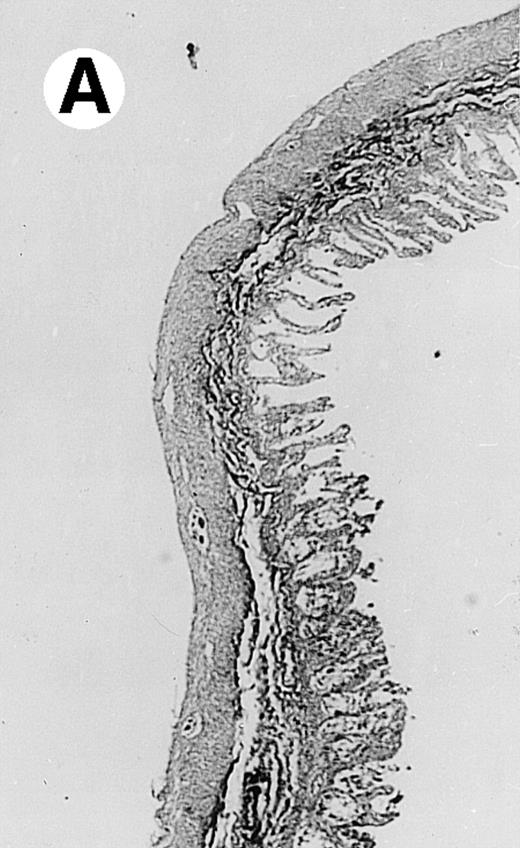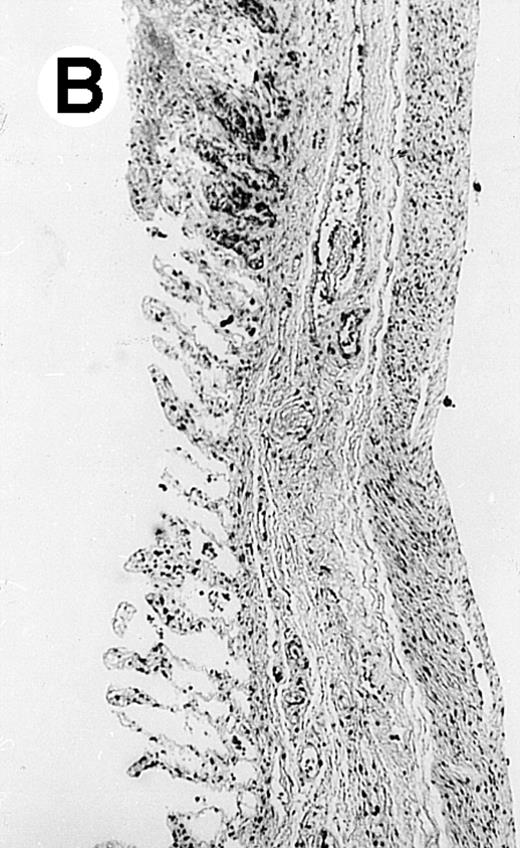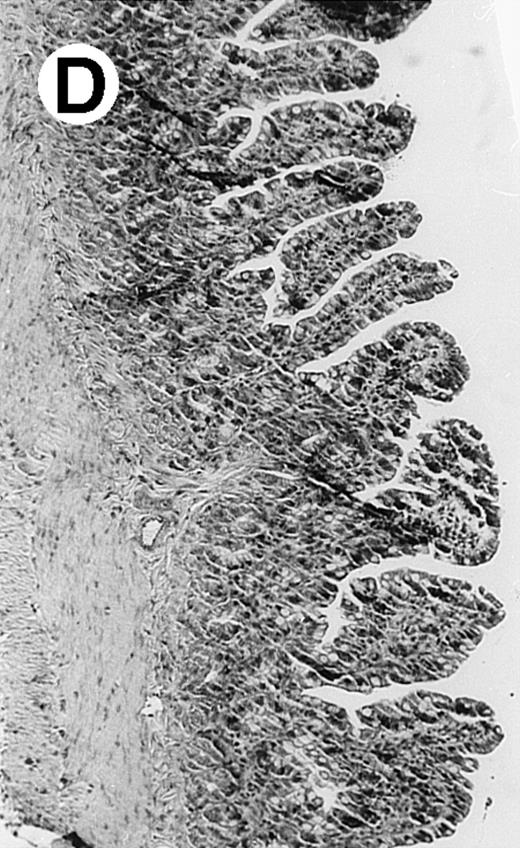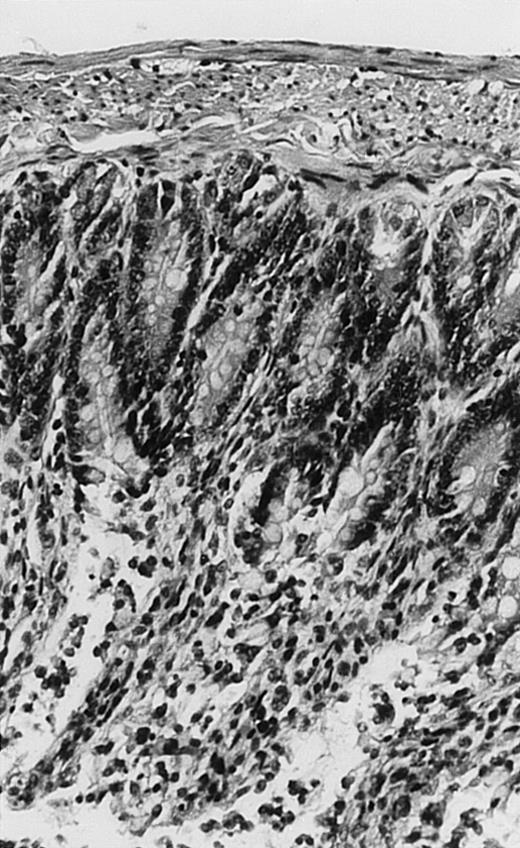Recombinant human granulocyte colony-stimulating factor (rhG-CSF) is widely used to promote granulocyte recovery from a variety of pathologic states. Recombinant human interleukin-11 (rhIL-11) has recently become available clinically as a platelet restorative agent after myelosuppressive chemotherapy. Preclinical data has shown that rhIL-11 limits mucosal injury after chemotherapy and attenuates the proinflammatory cytokine response. The potential efficacy of combination therapy with recombinant human forms of rhIL-11 and rhG-CSF was studied in a neutropenic rat model of Pseudomonas aeruginosa sepsis. At the onset of neutropenia, animals were randomly assigned to receive either rhG-CSF at a dose of 200 μg/kg subcutaneously every 24 hours for 7 days; rhIL-11 at 200 μg/kg subcutaneously every 24 hours for 7 days; the combination of both rhG-CSF and rhIL-11; or saline control. Animals were orally colonized with Pseudomonas aeruginosa 12.4.4 and then given a myelosuppressive dose of cyclophosphamide. rhG-CSF resulted in a slight increase in absolute neutrophil counts (ANC), but did not provide a survival advantage (0 of 12, 0% survival) compared with the placebo group (1 of 12 , 8% survival). rhIL-11 was partially protective (4 of 10, 40% survival); the combination of rhG-CSF and rhIL-11 resulted in a survival rate of 80% (16 of 20; P < .001). rhIL-11 alone or in combination with rhG-CSF resulted in preservation of gastrointestinal mucosal integrity (P < .001), lower circulating endotoxin levels (P < .01), and reduced quantitative levels of P. aeruginosa in quantitative organ cultures. These results indicate that the combination of rhIL-11 and rhG-CSF is additive as a treatment strategy in the prevention and treatment of experimental Gram-negative sepsis in immunocompromised animals. This combination may prove to be efficacious in the prevention of severe sepsis in neutropenic patients.
THE MANAGEMENT OF septic complications associated with intensive cytoreductive chemotherapy has improved significantly with the introduction of hematopoietic growth factors in clinical medicine.1,2 Nonetheless, patients with prolonged periods of neutropenia continue to suffer considerable febrile morbidity and remain at risk for potentially lethal systemic infections.3 Recent advances in the understanding of the protective role of the intestinal epithelium against microbial invasion4 and the interactions between multiple cytokines and growth factors offer the possibility that additional levels of protection may be afforded immunocompromised patients from septic complications.5
Recombinant human granulocyte colony-stimulating factor (rhG-CSF) has become the standard adjunctive therapy to promote granulocyte recovery after intensive chemotherapy.1 In clinical trials in cancer patients, rhG-CSF has been shown to significantly reduce the duration of fever and neutropenia after cytoreductive chemotherapy.6,7 In addition to its effects as a granulocytic growth factor, rhG-CSF has immunomodulatory effects that may benefit severely septic patients. rhG-CSF has been shown to promote neutrophil phagocytic and oxidative bactericidal activity.8-11 rhG-CSF may have some antiinflammatory properties as well. There is evidence that rhG-CSF can decrease the synthesis of proinflammatory mediators such as interleukin-12 (IL-12), interferon γ, and tumor necrosis factor (TNF)-α and increase the synthesis antiinflammatory mediators such as IL-10 and IL-1 receptor antagonist.812 The clinical relevance of these antiinflammatory activities of G-CSF in neutropenic patients are not clear at the present time.
IL-11 is a 178-amino acid, nonglycosylated multifunctional cytokine that belongs to the IL-6 family of GP130 receptor ligands.13 IL-11 binds to a unique alpha receptor14-16 and activates cells via the ubiquitous GP-130 signal transduction pathway.14,17,18 The recombinant human form of IL-11 (rhIL-11) has recently been approved for clinical use as a platelet restorative agent after chemotherapy-induced myelosuppression.19-21 This cytokine has a number of other potential therapeutic indications that are under preclinical and clinical development at the present time. IL-11 has the capacity to limit chemotherapy and radiation therapy-induced apoptosis of epithelial cells22 and maintain gastrointestinal mucosal integrity in a variety of pathologic states.4,23 24 This activity may be of particular value in the prevention of gut-derived bacterial translocation and sepsis in immunocompromised patients.
Our laboratory has previously shown that IL-11 given intravenously in high doses can rescue neutropenic animals from otherwise lethal sepsis from Pseudomonas aeruginosa.25 The current series of experiments were designed to test the hypothesis that IL-11 could provide additive benefit in combination with G-CSF after cytoreductive chemotherapy. This combination of growth factors was tested in an experimental system designed to mimic the pathophysiologic events that may occur in neutropenic sepsis in humans.26
MATERIALS AND METHODS
Reagents and bacterial strains.
The chemicals and reagents used in these experiments were obtained from Sigma (St Louis, MO) except for cefamandole, which was purchased from Eli Lilly (Indianapolis, IN). rhIL-11 was provided by Genetics Institute (Cambridge, MA) as the 177 amino acid human protein produced in Escherichia coli (E. coli). The rhG-CSF was obtained from Amgen (Thousand Oaks, CA). The bacterial challenge strain wasPseudomonas aeruginosa 12.4.4. This strain was initially obtained as a gift from A. McManus (United States Army Institute of Surgical Research, San Antonio, TX). This strain is a serum-resistant, human blood isolate belonging to Fisher-Devlin-Gnabasik immunotype 6.25
Animal model.
The details of the neutropenic rat model have been published in detail previously.25 In brief, female, Albino, specific-pathogen-free, Sprague-Dawley rats (Charles River Breeding Laboratories, Wilmington, MA) weighing 150 to 200 g were used in these experiments. The protocol was reviewed and approved by the Brown University Animal Care Committee and was conducted under National Research Council animal care guidelines. The animals were kept in biosafety cabinets and allowed to feed and drink water ad libitum.
The animals were first treated with cefamandole (100 mg/kg intramuscular [IM]) to disrupt bacterial colonization resistance within the rat gastrointestinal tract. Animals were then colonized with P. aeruginosa 12.4.4 by orogastric feeding of 106 bacterial colony-forming unit (CFU)/mL at time 0, 48, and 96 hours. Cyclophosphamide (Bristol-Myers, Evansville, IN) was given intraperitoneally at 150 mg/kg at time 0 and 50 mg/kg intraperitoneally at 72 hours.
Animals were monitored daily for evidence of overt illness and had temperature readings performed with a noncontact, digital, infrared thermometer (Horiba Instruments, Markson Sciences, Phoenix, AZ). At the onset of neutropenia (between 120 and 148 hours), blood samples were taken and treatment was instituted with rhIL-11 (200 μg/kg) subcutaneously every 24 hours for 7 days; rhG-CSF (200 μg/kg) subcutaneously every 24 hours for 7 days; the combination of rhIL-11 and rhG-CSF; or saline for the control group. Animals were randomly assigned to the saline control group (n = 12), rhG-CSF + saline (n = 12), rhIL-11 + saline (n = 10), or the combination of rhG-CSF + rhIL-11 (n = 20).
Periodic blood sampling was performed from the retro-orbital plexus under light CO2 anesthesia. Blood was obtained for white blood cell counts (by Coulter counter, Coulter Corp, Miami, FL) and serum endotoxin (by quantitative turbidimetric Limulus Amebocyte Lysate assay, Associates of Cape Cod, Woods Hole, MA). Blood cultures were obtained at the onset of fever and quantitative bacteriology was performed by standard methods (Pseudomonas isolation agar and serotypic methods [Difco, Detroit, MI]).
Animals were observed several times daily for up to 14 days after the cyclophosphamide dose when bone marrow recovery was complete. Each animal that succumbed from infection and those animals that survived the experiment were killed and subjected to necropsy examination. Histologic examination of the lung, liver, kidney, adrenal, and the small and large intestine was performed by a pathologist who was unaware of the treatment given to each animal. A histologic score for gastrointestinal pathology was developed as follows: 0, normal; 1, minimal thinning of mucosa; 2, moderate thinning and inflammation; 3, marked thinning and inflammation with focal areas of necrosis; 4, diffuse thinning and necrosis.
Statistical analysis.
Numeric values are presented as mean ± standard deviation. Continuous variables were analyzed by a one-way analysis of variance (ANOVA) followed by the Tukey-Kramer multiple comparisons test for multiple groups or Mann-Whitney U-test for two groups. Survival functions are presented as a Kaplan-Meier plot and differences in survival time were determined by the ANOVA. P values less than .05 were considered significant.
RESULTS
Effects of combination therapy on survival.
Kaplan-Meier plot of the survival function for each group in these experiments is provided in Fig 1. Animals that succumbed over the experimental period had histopathologic evidence of multisystem infection with the challenge strain ofPseudomonas aeruginosa 12.4.4 and pathologic findings of acute tubular necrosis, adrenal hemorrhage, pulmonary congestion, and diffuse interstitial edema. rhG-CSF even at doses of 200 μg/kg was not able to salvage these animals from lethal infection from Pseudomonas aeruginosa. rhIL-11 alone was partially protective (40% survival;P < .05) and the combination of rhG-CSF and rhIL-11 resulted in the most favorable outcome (16 of 20 or 80%; P < .001). The combination was superior to rhIL-11 alone (P < .05).
Kaplan-Meier survival plot of animals treated with rhG-CSF, rhIL-11, combination of both growth factors, or the control group.
Kaplan-Meier survival plot of animals treated with rhG-CSF, rhIL-11, combination of both growth factors, or the control group.
Pathologic and microbiologic findings.
Pathologic findings in the small and large intestine were strikingly different depending on the treatment group. Figure 2A shows a representative pathologic sample from an animal assigned to the control group. Marked thinning of the bowel wall and extensive areas of epithelial cell sloughing was noted. Animals randomized to rhG-CSF treatment had minimal improvement in histologic findings with focal regions of preserved epithelium (Fig2B). Animals randomized to the rhIL-11 group showed substantial improvement with thickening of the epithelial layer and preservation of mucosal cell integrity (Fig 2C). Animals receiving both rhG-CSF and rhIL-11 had the most favorable histologic findings with normal mucosal thickness, minimal inflammatory changes, and preserved tissue architecture (Fig 2D). The composite analysis of the gastrointestinal pathology is provided in Table 1.
Histopathology of small intestinal mucosa cut in transection from an animal in each treatment group (study day 8). The upper panel (row 1) is a low power view (original magnification × 57); the lower panel (row 2) is a high power view (original magnification × 144). Note the diffuse thinning and necrosis of the mucosa with sloughing of intestinal epithelial cells in the control animal (A). There is progressive recovery of the thickness of the mucosa, reduction in inflammatory changes, and improved epithelial architecture with rhG-CSF (B), rhIL-11 (C), and combination therapy with rhG-CSF+IL-11 (D).
Histopathology of small intestinal mucosa cut in transection from an animal in each treatment group (study day 8). The upper panel (row 1) is a low power view (original magnification × 57); the lower panel (row 2) is a high power view (original magnification × 144). Note the diffuse thinning and necrosis of the mucosa with sloughing of intestinal epithelial cells in the control animal (A). There is progressive recovery of the thickness of the mucosa, reduction in inflammatory changes, and improved epithelial architecture with rhG-CSF (B), rhIL-11 (C), and combination therapy with rhG-CSF+IL-11 (D).
The microbiological findings from blood cultures and organ cultures are found in Table 1. Bacteremia from the challenge strain ofPseudomonas aeruginosa was detected in one or both quantitative blood cultures obtained at the onset of fever in over 75% of the animals. Treatment with either rhG-CSF or rhIL-11 or the combination did not significantly reduce the frequency of bacteremia. There is a trend towards reduced quantitative levels of bacteremia in the animals treated with rhIL-11 or the combination of rhIL-11 and rhG-CSF, but these differences did not reach statistical significance. The tissue levels of bacterial densities and circulating levels of bacterial endotoxin were significantly reduced by rhIL-11 alone or the combination of rhIL-11 and rhG-CSF. The rhG-CSF alone treatment group had a trend towards reduced tissue concentrations of P.aeruginosa compared with the control group, but this difference did not reach statistical significance.
The effects of rhG-CSF and rhIL-11 on the ANC over the course of the experiments are provided in Fig 3. In preliminary dose-finding experiments, rhG-CSF at this dose regimen was capable of significant improvements (fivefold increase over control) in neutrophil counts (data not shown). In the current set of experiments, rhG-CSF resulted in a twofold to threefold increase in neutrophil counts during the nadir of severe neutropenia (day 5; P < .05); however, only the combination of rhIL-11 and rhG-CSF exhibited a sustained increase in neutrophil counts throughout the entire neutropenic period (P < .01).
ANC/mm3 over the course of the 14-day experimental period in each treatment group. Neutrophil recovery was significantly accelerated by the combination treatment (rhG-CSF + rhIL-11) compared with each treatment alone or the control group (P < .01).
ANC/mm3 over the course of the 14-day experimental period in each treatment group. Neutrophil recovery was significantly accelerated by the combination treatment (rhG-CSF + rhIL-11) compared with each treatment alone or the control group (P < .01).
DISCUSSION
Recombinant human IL-11 has consistently afforded protection in neutropenic animals whether given intravenously alone,27with antimicrobial agents,25 or subcutaneously as observed in the current trial. In addition to its hematopoietic effects, rhIL-11 has antiinflammatory properties that attenuate the production of the proinflammatory cytokines. rhIL-11 has been shown to decrease the production of TNF-α, IL-12, interferon γ, and the synthesis and release of nitric oxide.17 rhIL-11 limits the hemodynamic effects of endotoxin challenge in an experimental sepsis model28 and provides a survival advantage in animals exposed to an otherwise lethal challenge with Gram-positive bacteria or superantigen-induced shock.29
The mechanism of inhibition of proinflammatory cytokine synthesis by rhIL-11 appears to be related to its ability to induce the synthesis of IκB in monocytes. IκB binds to NFκB in the cytoplasm of cells and prevents its nuclear translocation. NFκB is an important transcriptional activator for a large number of proinflammatory cytokines including TNF-α and IL-1β. Inhibition of nuclear translocation of NFκB by rhIL-11 downregulates cytokine synthesis by CD14+ mononuclear cells.30 Moreover, recent evidence suggests that rhIL-11 also directly affects T-cell function. rhIL-1I promotes a Th2-type cytokine response in experimental animal models after allogeneic bone marrow transplantation.31
rhIL-11 has been shown to have marked effects on gastrointestinal epithelial surfaces. rhIL-11 blocks apoptosis of epithelial cells exposed to radiation and chemotherapy in mice.22 rhIL-11 is protective in a variety of mucositis models and in models of intestinal inflammation.4,23,24 rhIL-11 has been shown to prolong the G-0 phase of growth of intestinal epithelial cells. The precise mechanism of action is not known, but it has been observed that rhIL-11 decreased pRB (retinoblastoma protein) phosphorylation (an important signaling event in cell cycling) within intestinal epithelial cells.32 rhIL-11 has protective effects on gastrointestinal mucosa in transgenic rats, which possess HLA-B27 antigens.4These animals develop an inflammatory colitis that is similar in many respects to human inflammatory bowel disease. rhIL-11 treatment in these animals decreases intestinal inflammation and chronic diarrhea. Based on these preclinical findings, rhIL-11 is currently in clinical trials in both inflammatory bowel disease and chemotherapy-induced mucositis.33 The remarkable capacity of rhIL-11 to protect the gastrointestinal mucosal integrity after chemotherapy is apparent in the current series of experiments (Fig 2).
The beneficial effects of rhIL-11 in the neutropenic rat model may be mediated by its activity as a hematopoietic growth factor, an antiinflammatory cytokine, or its ability to maintain gastrointestinal epithelial integrity.25,33 The results of the current study would favor rhIL-11 protective effects on the intestinal epithelium as the principal mechanism protection in these animals. Maintenance of the gastrointestinal barrier function should diminish the frequency of gut translocation-derived bacterial infection after chemotherapy-induced myelosuppression and epithelial injury.25 The remarkable preservation of membrane integrity found on the gastrointestinal pathologic samples, the reduced circulating levels of endotoxin, and the reduced bacterial load in organ cultures support a dominant role for epithelial protective effects by rhIL-11 treatment in this animal model.
The modest effects of rhG-CSF in the granulocyte recovery observed in these animals did not result in a survival advantage in the presence ofPseudomonas aeruginosa sepsis. This may be attributed to some species differences in the avidity of human recombinant G-CSF in the rat. It is of interest to note that rhG-CSF has previously been shown to be efficacious in neutropenic mice with experimental sepsis11,34 and rats with intraabdominal sepsis.12 The lack of protection observed in the current study may be a consequence of the intrinsic virulence of the infecting strain of P. aeruginosa,26 the route of the septic challenge, the duration of neutropenia, and the absence of antimicrobial agents directed against the challenge strain in this series of experiments.25
The combination of rhIL-11 and rhG-CSF was additive and potentially synergistic in the prevention against lethality in the neutropenic rat model. The combination treatment resulted in 80% survival, while less than 10% of animals in the control group survived. rhIL-11 may reduce accumulation of pulmonary edema fluid that has been associated with the rhG-CSF treatment given as a single agent.1 This may be the result of the antiinflammatory effects of rhIL-11. rhIL-11 attenuates the excess production of proinflammatory cytokines that may be deleterious in systemic inflammatory states such as septic shock.35
The explanation for the added benefit of rhG-CSF to rhIL-11 therapy alone has not been identified in this study. It may be related to the promotion of phagocytic activity and oxidative bactericidal capacity neutrophils by rhG-CSF therapy.8-11 It is also possible that the combination of rhIL-11 and rhG-CSF expanded the neutrophil pool in these animals. rhIL-11 promotes early progenitor stem cell differentiation and acts in concert with other growth factors such as rhG-CSF to promote granulocyte development. The two hematopoietic growth factors have been shown to be synergistic in the promotion of granulopoiesis.36 It is possible that the expansion of the absolute neutrophil population within the animal may not have been detected from measurements of circulating granulocyte populations in these septic animals with severe chemotherapy-induced neutropenia.
In summary, the results indicate that the combination of rhG-CSF and rhIL-11 was additive in the prevention of mortality in this experimental model of neutropenic sepsis. The model is designed to mimic the pathophysiologic events that may occur in patients after cytoreductive chemotherapy.25 26 The animals are colonized by the opportunistic bacterial pathogen, Pseudomonas aeruginosa. The animals subsequently develop Gram-negative sepsis as a result of translocation of bacteria across a damaged gastrointestinal mucosal barrier. The presence of neutropenia prevents the rapid clearance of microbial pathogens and multisystem infection and sepsis results. Animals develop bacteremia and endotoxemia and succumb from multiorgan failure unless specific therapy is instituted.
Recent evidence indicates that the salutary effects of IL-11 on gastrointestinal membrane integrity may extend to the respiratory epithelium as well.37 Transgenic mice that express increased amounts of IL-11 on respiratory epithelial surfaces were protected from hyperoxia-induced lethality and had reduced expression of IL-1 and TNF in airways exposed to 100% oxygen. IL-11 also protects the mucous membranes of the oropharnynx for chemotherapy-induced mucositis in experimental animal systems.4 The mucosal protection afforded by rhIL-11 may prove to be generally applicable in a wide range of potential therapeutic indications.
The advantageous effects of the combination rhG-CSF and rhIL-11 in this experiment suggests that a similar approach might be useful in the management of chemotherapy-induced myelosuppression in patients. The desirable attributes of rhIL-11 combined with the established capacity of rhG-CSF to promote granulocyte recovery may diminish infection risk in neutropenic patients. The combination strategy will need to be studied in clinical trials to determine if additive or synergistic effects accrue from rhG-CSF and rhIL-11 therapy in the management of neutropenic patients.
Supported by Genetics Institute, Cambridge, MA.
The publication costs of this article were defrayed in part by page charge payment. This article must therefore be hereby marked “advertisement” in accordance with 18 U.S.C. section 1734 solely to indicate this fact.
REFERENCES
Author notes
Address reprint requests to Steven M. Opal, MD, Infectious Disease Division, Memorial Hospital of Rhode Island and Brown University School of Medicine, 111 Brewster St, Providence, RI 02860.











